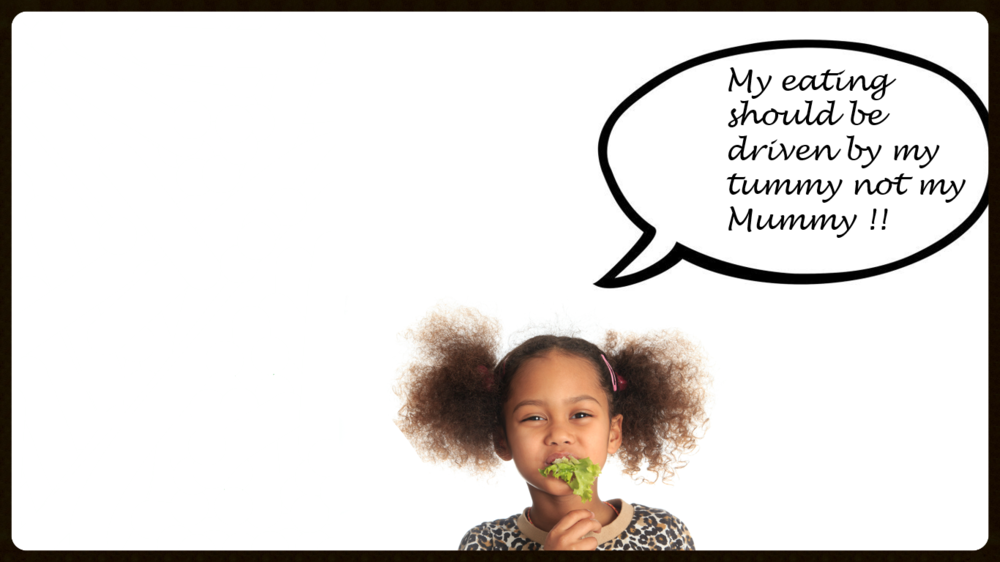Give your child the gift of self-regulation
Self-regulation, in relation to food and eating*, is the process whereby we listen our bodies’ cues; eating because we are hungry and stopping because we are full.
Put simply, our bodies send signals to our brains which the brain translates into actions (the choice to eat or stop eating). This is actually an extremely complex and subtle system .This physiological mechanism is hard-wired; think of a tiny baby crying because she is hungry, drinking her milk because her body is telling her to, then finishing her feed because she feels that she has had enough.
It might seem odd, then, to talk about it being a gift you can give your child. How can we give our children something that they are already born with? The answer is that our job is to nurture their ability to self-regulate because if we don’t, we can block it.
Children’s ability to self-regulate can be blocked in the following ways:
- Failure to provide regular, appropriate meals so that children don’t have the opportunity to get used to a healthy rhythm of feeling hungry then feeling full throughout the day.
- Over-protecting children from hunger so that they are given food before their bodies signal that they need it.
- Putting pressure on children to eat so that they are eating because of the adults around them.
- Giving children messages that confuse food with feelings so that children learn to eat for emotional reasons.
- Failure to ensure that there will always be sufficient accepted foods available at every eating opportunity to satisfy hunger** (alongside other foods).
- Restricting children’s eating by telling them they have to stop eating because they have had enough
Three things you can do today to help your child self-regulate:
Modelling
The most powerful influence on how a child eats is how the adults around them eat. ‘Do as I say, not as I do’ just doesn’t work. If you want your child to learn how to self-regulate, demonstrate it for them again and again. For example, you could reflect out-loud that you are choosing to leave a couple of mouthfuls of your meal as your tummy is telling you that you have had enough ( especially hard for the waste-haters out there like me…) .
Conversely, you could say that you’re going to help yourself to some seconds because, even though you have eaten all your food, your tummy still feels hungry.
Think before you speak
How you talk about food is really important – if you talk about eating in a way that is emotionally laden, your children will learn from you to associate food and feelings. For example, if you are on a diet, you may inadvertently pass on your own difficult feelings about eating, including shame and guilt.
If your children think that it’s normal to reward yourself with a cookie or berate yourself for a second helping of dessert, they are more likely to grow up seeing food as something that is connected to our feelings of self-worth.
It’s great to be enthusiastic about food and to enjoy it with your child – I’m not advocating a view of food simply as fuel – food can be joyous – it’s just gets unhealthy when it gets tied up with our feelings about ourselves.
Let your child make their own decisions
Not about what food they are given, that’s up to you. But about how much of it they eat. This is what Ellyn Satter dubbed DOR (Division of Responsibility in feeding) and is a vital concept to understand if you want your child to grow up learning how to self-regulate.
Every time you push your child to try ‘one more bite’ or go for that clean plate, you are actually hampering their ability to self-regulate. By trusting them to decide how much they need, you are helping them learn to tune into their bodies.
*Self-regulation is used in a wider context to talk about impulse-inhibition and the internal control of emotion and attention. I am using it specifically to refer to the process of making decisions to eat based on physiological rather than external cues. This is known as ‘self-regulation of energy intake’.
** Satter, E. (2007) Eating Competence: Definition and Evidence for the Satter Eating Competence Model. Journal of Nutrition Education and Behavior: Supplement, 39, 5



[…] Is it? Or is your job to help your child learn to self-regulate and make their own eating decisions? Can you simply set an appropriate structure and then leave it […]
[…] reduces children’s ability to self-regulate (eat in response to their body’s […]
[…] of how we eat and how we feel about ourselves. These emotions take us further from our ability to self-regulate – to eat for internal instead of internal […]